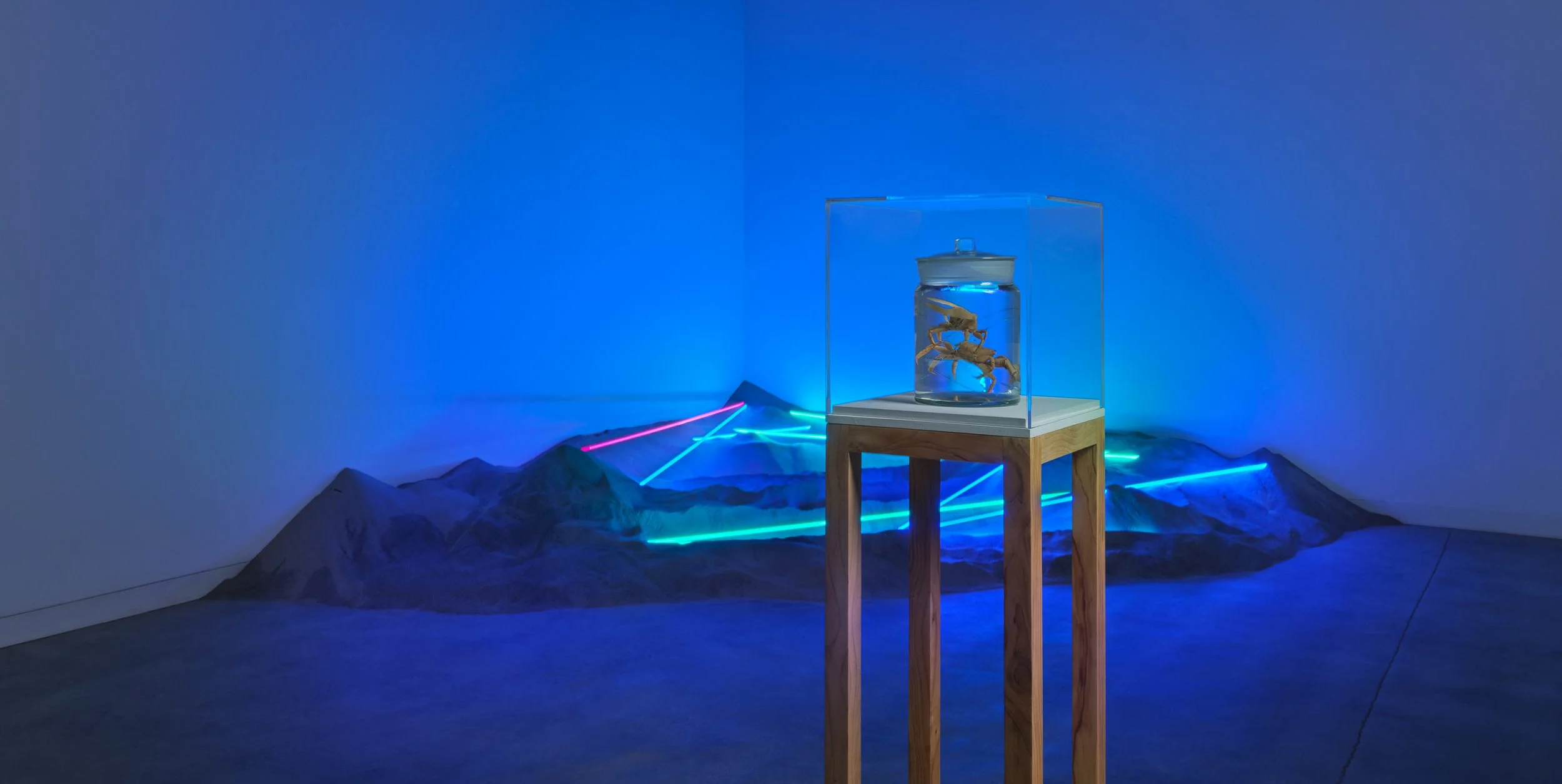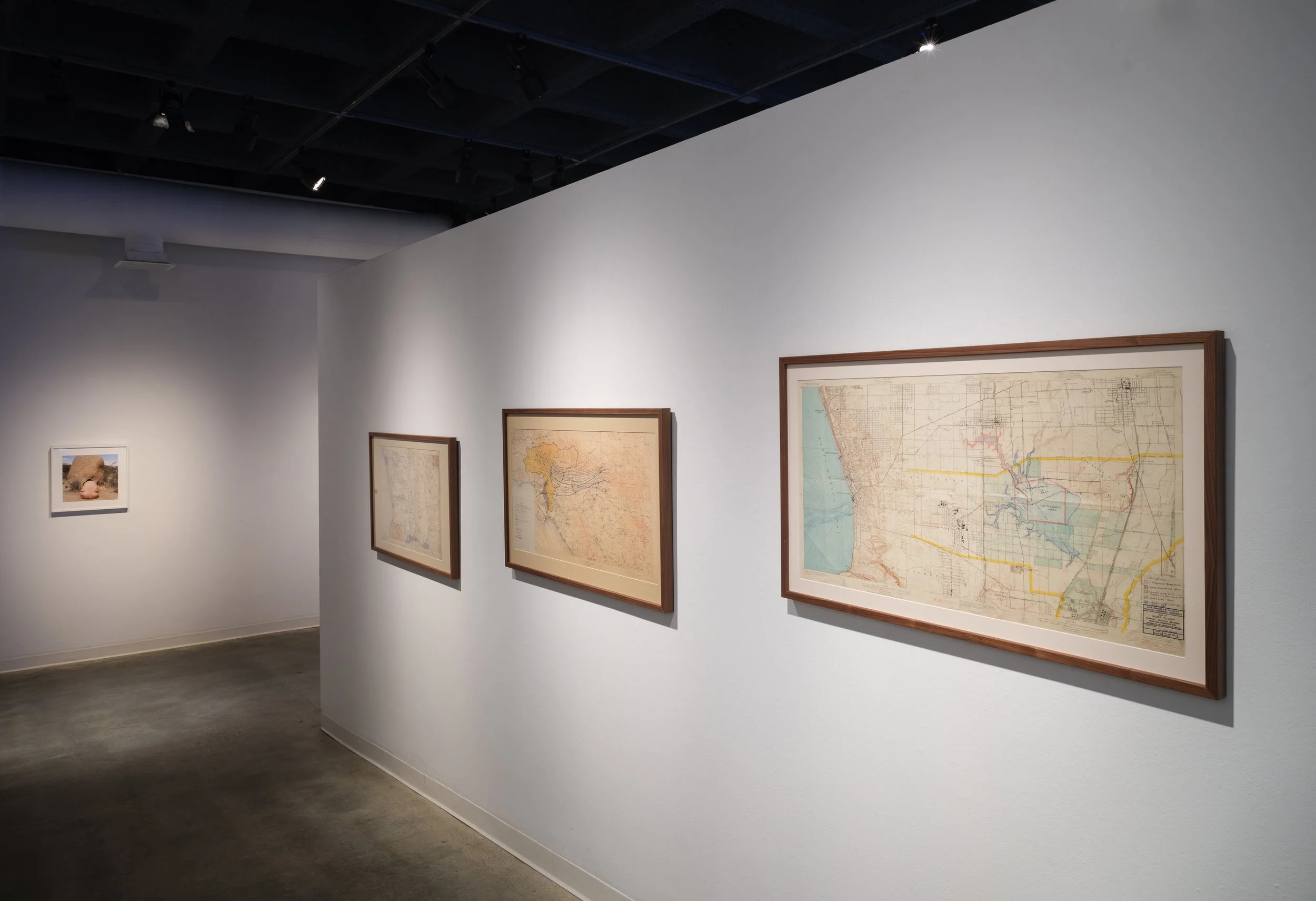Dominguez Hills University Art Gallery | Brackish Water Los Angeles (PST ART)
Climate Impact Report
08/12/2024 12/14/2024 18 weeks
11-25 artists 6-25 artworks
This exhibition participated in the PST ART Climate Impact Program, support by Getty and LHL Consulting.
Brackish Water Los Angeles, from its inception, reflected a commitment to sustainability and environmental stewardship. Key climate focused actions included prioritizing local artworks to minimize travel emissions, reducing waste by avoiding the construction of temporary walls, and reusing packaging materials. Our exhibition shared environmental resources throughout the research and exhibition process, with CSUDH students engaged as research assistants to deepen their involvement.
Brackish Water Los Angeles collaborated closely with the campus sustainability office, multiple other university departments, and the student body. One notable initiative included repurposing 6,500 pounds of sand used in a temporary installation to benefit CSUDH’s Child Development Center. Additionally, Brackish Water Los Angeles received a materials stipend from Artist Commit, allowing the use of wood from already fallen trees, further deepening our dedication to low-impact practices.
Emissions
In order to access energy data, we worked with the CSUDH facilities team. They were able to identify the average energy use of the specific gallery and adjoining office for the time period the exhibition is open, which we attributed to the show. This far surpassed our emissions from three domestic flights and artwork shipping to be the most significant emission area for our exhibition.
Travel
1.45 tCO2e
Flight (domestic)
Shipping
0.06 tCO2e
Road Freight - Shuttle (long haul), Road Freight - Local
Building Energy
42.31 tCO2e
We have access to energy data. This exhibition incorporated energy saving initiatives.
Total Emissions 43.76 tCO2e
Materials & Waste
Pedestal/Plinth, Vitrine/Display, Reusable Packing, Wall Vinyl
Material Sources
New, Reclaimed/Diverted
Material Destinations
Sold/Donated, Recycled, Landfill
Waste reduction strategies implemented, Designed for disassembly, Plastic/petro-based materials
Waste Report Details:
Designing the exhibition with a focus on waste reduction was a key element of the curatorial process. From the outset, we aimed to avoid the material footprint associated with building walls, so we intentionally altered the gallery’s architecture through the thoughtful selection and placement of artworks. This allowed us to maintain an entirely open space, fostering dialogue between the works. For example, one artwork forms a wall of inflatables, purposefully interrupting the space and literally reframing the visitor experience.
To minimize the use of new materials, we applied for and received an Artists Commit materials stipend, which enabled us to collaborate with Angel City Lumber, a local lumber yard that mills naturally fallen trees in Los Angeles. Although this high-quality cedar was more expensive than pine, it became a key feature of the plinths. The 'skeleton' design of the plinths, made entirely from reclaimed materials, eliminated the need for plywood. This choice saved approximately 160 square feet of virgin plywood, plus the additional framing wood typically required. The cost of materials for standard white plinths, which have limited reuse, is about $200, while the cedar skeleton plinths cost $650. Though the initial expense was signicantly higher, the long-term reusability of these plinths provides better value. We were thrilled to learn that colleagues have replicated this design, also using reclaimed materials.
Despite understanding the long-term benefits of investing in high-quality materials and craftsmanship, we faced significant budget constraints. Without the support of Artists Commit, this plinth approach may not have been feasible. Unexpectedly, by committing to using fewer materials, the plinth design itself became a standout feature of the exhibition. Without the mass of solid plinths, visitors enjoyed unobstructed views throughout the gallery.
For Jenny Kendler’s work, the artist (with support from the exhibition budget) commissioned a custom 'forever' shipping crate that doubled as a presentation device for the sculpture. This crate was used to safely transport the piece back to the artist.
The only items going to landfill are wall vinyl and plastic sheeting. Vinyl gloves were recycled through a campus program initially launched by the science department and now being used university-wide. The campus Sustainability Office Green Office Program offers Zero Waste Kits for lab staff and access to a free glove recycling program, which we used during de-installation.
Catalog
There is a hard-cover print publication connected to this project.
Engagement
Stakeholders engaged in the Climate Impact Report:
Director/Leadership, Curatorial, Exhibitions / Install, Development, Communications / Marketing, Artists, Fabricators, Audiences
Climate related wall text, Climate incorporated into exhibition thematic content
Our Team
The entire project team participated in the Climate Impact Program from the outset. Early in our research phase, we had a team meeting discussing the CIP and how it would inform our approach to building Brackish Water Los Angeles. Co-director Debra Scacco is, with Laura Lupton, the co-lead of the Getty PST ART Climate Impact Program. She and co-director Aandrea Stang frequently discussed climate considerations in their decision making. Project coordinator Sarah Yanni spoke at length with shippers about carbon impacts of shipping. Head preparator Greg Mocilnikar participated in all discussions regarding climate impact decision making, and was instrumental in implementing these strategies in the lead up to installation and deinstallation. Project Manager Michelle Santos was key in keeping us on track with our climate impact goals, as well as being an experienced and effective community organizer, leading efforts including providing bus transportation on community day; outreach to special interest groups on campus; and building connections with other departments across the university. Exhibition designer Brian Boyer and fabricator Christopher Kendzierski designed and fabricated high quality casework that will be reused in perpetuity.
Our Community
The University Art Gallery at California State University, Dominguez Hills serves a wide range of audiences, including our 14,000 students. Recognizing this, the project co-directors developed a course that engaged two cohorts of students as research assistants for the Brackish Water Los Angeles project. This course explored the scientic, ecological, and metaphorical dimensions of brackish water, featuring talks from various university departments—such as science and archives—as well as from external environmental advocates. Students' contributions are recognized as part of the research team in the exhibition catalog.
Within the university, we collaborated with departments such as science, women’s studies, education, and first-year experience through tours, talks, and guest lectures. Graduate students from the University of Utah and Cal State Fullerton also visited for guided tours.
We were fortunate to collaborate with East Yard Communities for Environmental Justice and the Sacred Places Institute as advisors, incorporating their perspectives into the exhibition through film screenings and VIP tours. Additionally, we highlighted environmental groups that influenced the project through our website and gallery guide.
Our participation in the Bloomberg Connects program expanded the exhibition’s accessibility to audiences outside of our immediate community. This platform also enabled us to produce physical gallery guides that included context for each artwork, community resources, and offsite artworks.
Beyond the campus, off-site artworks were sited in Santa Monica, North Hollywood and Long Beach in efforts for visitors to directly engage in the ecologies highlighted in the research and exhibition. On campus, we placed a significant ecological artwork in a highly visible area, attracting both students and visitors to the exhibition. In addition, we collaborated with the Physics Department to host a biochar art-based workshop, and with the LA Promise Fund and Arts Matter to create Spanish translations for our gallery guide. We hosted a Community Day where, in addition to our always free admission, we provided free parking (waiving the usual $10 fee, a barrier to entry for many). A translator was present throughout the Community Day, including for our curator-led gallery tour, ensuring accessibility for our Spanish-speaking community. We also partnered with Friends of the Los Angeles River (FOLAR) for a community cleanup at Sepulveda Basin. These and all additional events were focussed on environmental concerns.
Reflections & Takeaways
A critical component of Brackish Water Los Angeles was ensuring that sustainability and environmental stewardship were at the heart of our process. From the outset, we made climate-conscious decisions— ranging from minimizing travel emissions by prioritizing local artists to repurposing materials, such as the 6,500 pounds of sand used in the exhibition to benefit CSUDH’s Child Development Center.
Our team embraced a holistic approach, with every member contributing to climate-focused decision making. Project managers, exhibition designers, and CSUDH students alike were engaged in discussions and implementations around reducing our carbon footprint. By integrating the Climate Impact Program’s goals into our curatorial process, we expanded beyond the gallery space, involving community partners and the student body and building community around these actions. For example, students acted as research assistants, contributing to the exhibition catalog, and we fostered educational programming with workshops and guided tours.
Brackish Water Los Angeles stands as a model of how art, community engagement, and environmental action can intersect. The exhibition not only raised awareness and provided calls-to-action, but also demonstrated how low-impact practices can enhance both the aesthetic and practical aspects of curation. Our work underscored the importance of collaboration in creating meaningful, climate-conscious exhibitions. The work inspired by this process and by the Climate Impact Program continues to inform our practices long past this exhibition.
Credits
This Climate Impact Report was prepared by Michelle Santos, who is deeply committed to fostering sustainability initiatives at California State University, Dominguez, particularly within the context of the University Art Gallery. The process of developing the report was both enriching and collaborative, providing opportunities to explore innovative ways to integrate sustainable practices into the gallery.
What stood out most was the collaboration with both the campus community and neighboring communities, which brought diverse perspectives and solutions to the table. This inclusive approach underscored the value of partnership in achieving meaningful environmental impact.
This Climate Impact Report was completed as a part of the PST ART Climate Impact Program, a groundbreaking initiative integrating climate action, community building, and reporting into Getty’s landmark arts event, led by LHL Consulting. More information can be found at pst.art/climate.








